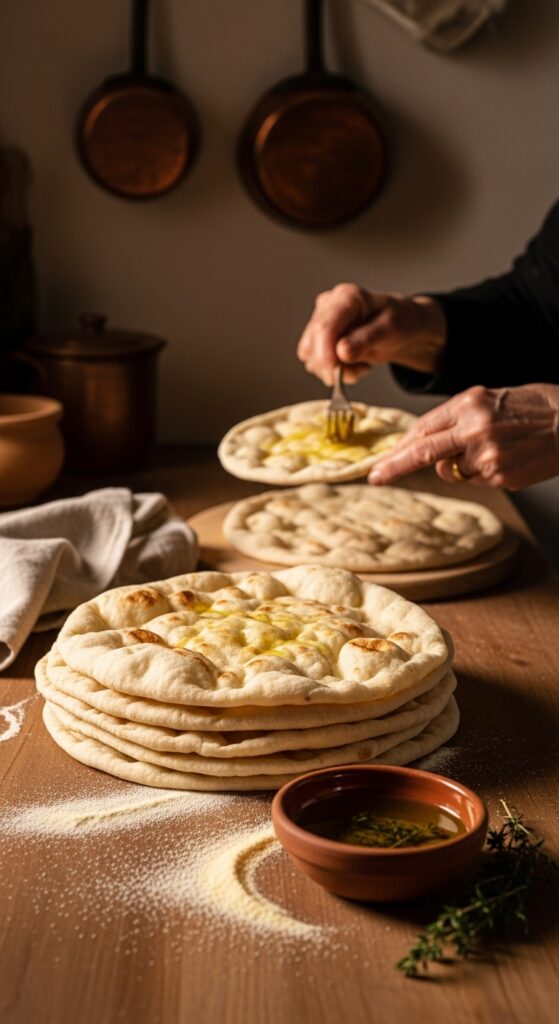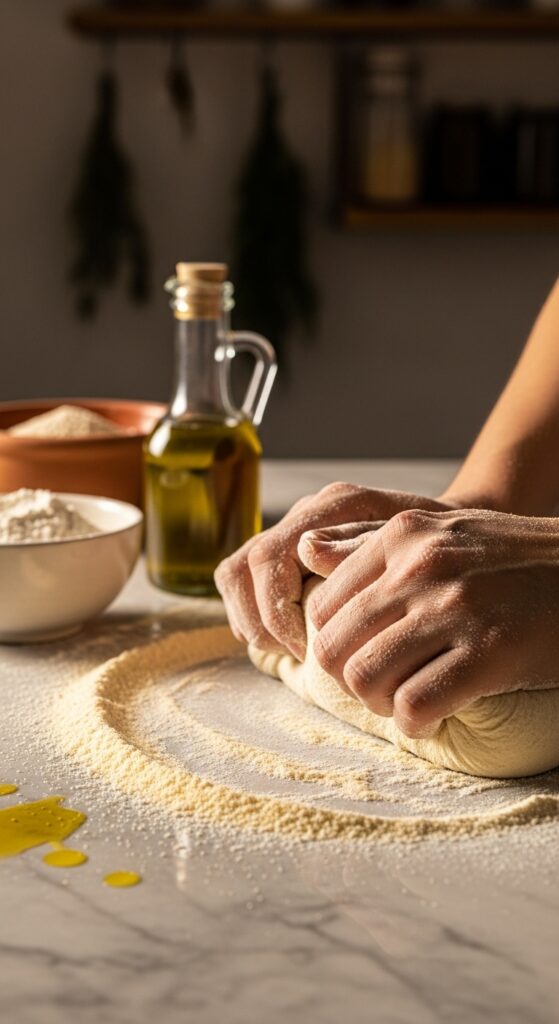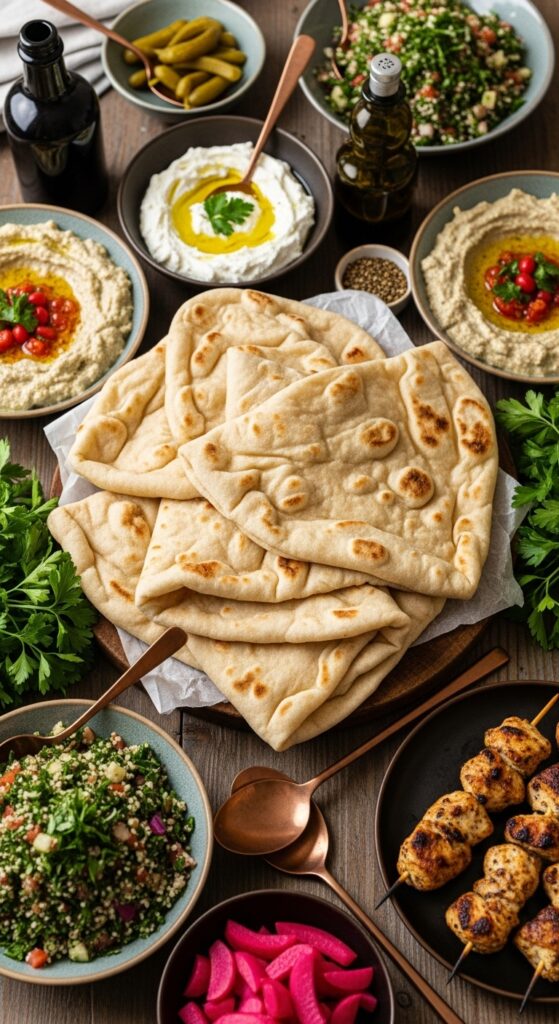You know that warm, comforting smell that fills a kitchen when bread hits a hot oven? That’s the scent of life in the Levant. The smell that drifts through tiny bakeries on old Beirut streets, through homes where grandmothers still bake the way their mothers did. Today, we’re making something deeply simple yet endlessly satisfying — Soft Lebanese Khubz Bread with Semolina and Olive Oil.
This bread is soft but structured, humble yet rich with heritage. It’s not just bread; it’s the edible heartbeat of Lebanese tables.

Why This Bread Is Special
Khubz — sometimes spelled khobz, khoubz, or simply “flatbread” — is the backbone of Lebanese cuisine. It’s that versatile pocket bread you tear, scoop, wrap, and dip. It’s the loyal companion to hummus, baba ghanoush, or even just a drizzle of olive oil and za’atar.
What makes this particular version shine is the use of semolina flour. Semolina brings a gentle chew and that golden hue that whispers, “I’ve been kissed by the sun.” When combined with olive oil, it creates a silky dough that bakes up beautifully — soft inside, slightly crisp outside, and full of soul.
You’ll taste the Levant in every bite. Earthy, nutty, fragrant — it’s bread that connects hands across generations.
Ingredients & Substitutions

Let’s get you prepped. Lebanese khubz doesn’t need fancy tools, but it does appreciate good ingredients.
Dry Ingredients
- 2 cups all-purpose flour – gives lightness and elasticity.
- 1 cup fine semolina flour – for flavor and golden color.
- 1 tsp instant yeast – quick, reliable lift.
- 1 tsp sugar – helps yeast activate and adds slight sweetness.
- 1 tsp salt – balances flavor, never skip it.
Wet Ingredients
- ¾ cup warm water – not hot, just warm enough to wake the yeast.
- 2 tbsp olive oil – for that distinct Lebanese richness.
Optional Enhancements
- 1 tbsp yogurt – makes it extra tender.
- A drizzle of honey – adds warmth if you like a hint of sweetness.
Substitutions & Tips
No semolina? Use 100% all-purpose flour, though you’ll lose a touch of color and texture.
Want it whole-grain? Swap half the flour for whole wheat and add an extra tablespoon of water.
Olive oil can be replaced with avocado oil or melted butter — but olive oil keeps it authentically Mediterranean.
For vegan versions, stick to olive oil and water; skip the yogurt.
Always measure flour gently — scoop, then level. Packed flour makes heavy dough.
Pro tip: The yeast doesn’t like hot water. Aim for lukewarm, around 100°F (38°C) — warm like bathwater. If it’s too hot, you’ll kill it, and your khubz will sulk instead of rise.
Step-by-Step Instructions

Step 1: Mix & Activate
In a large bowl, combine warm water, yeast, and sugar. Let it sit for 5 minutes until it bubbles — a little foamy layer means your yeast is alive and kicking.
Step 2: Build the Dough
Add flour, semolina, and salt. Drizzle in the olive oil. Mix with your hand or a wooden spoon until a rough dough forms. It’ll be shaggy and slightly sticky — that’s perfect.
Step 3: Knead for Glory
Turn the dough onto a lightly floured surface. Knead for about 8–10 minutes until smooth and elastic. Push, fold, turn. Feel it come alive under your palms. This part is almost meditative.
If it’s too sticky, sprinkle a bit of flour — but resist adding too much. Soft dough equals soft bread.
Step 4: Let It Rest
Place the dough in an oiled bowl, cover with a damp cloth, and let it rise for 1 hour. It should double in size and feel airy when you poke it.
Step 5: Shape the Khubz
Punch down the dough to release air. Divide into 6–8 pieces. Roll each one into a ball, then flatten gently into a 6-inch circle, about ¼ inch thick.
Cover the rolled dough with a towel so they don’t dry out.
Step 6: The Bake
Heat your oven to 475°F (245°C) — hot enough to make those pockets pop. Place a baking stone or heavy sheet inside while preheating.
Lay a dough circle on the hot surface and bake for 2–3 minutes per side until puffed and lightly golden. You can also use a skillet on the stovetop — medium-high heat, flip once bubbles appear.
Step 7: Soften & Store
Wrap the baked khubz in a clean towel to keep them soft. The steam inside keeps the texture perfect.
Recipe Card
Soft Lebanese Khubz Bread with Semolina and Olive Oil
Prep Time: 15 minutes
Rise Time: 1 hour
Cook Time: 15 minutes
Total Time: 1 hour 30 minutes
Servings: 6–8 pieces
Ingredients
- 2 cups all-purpose flour
- 1 cup fine semolina flour
- 1 tsp instant yeast
- 1 tsp sugar
- 1 tsp salt
- ¾ cup warm water
- 2 tbsp olive oil
- (Optional) 1 tbsp yogurt, 1 tsp honey
Instructions
- Mix warm water, yeast, and sugar. Let it sit until foamy.
- Add flour, semolina, salt, and olive oil. Mix into a dough.
- Knead 8–10 minutes until smooth.
- Cover and let rise 1 hour until doubled.
- Punch down and divide into 6–8 balls.
- Flatten each to ¼ inch thick circles.
- Bake on a preheated stone at 475°F for 2–3 minutes per side, or cook on a hot skillet.
- Wrap warm khubz in a towel to stay soft.
Nutrition (per piece)
Calories: 160
Protein: 4g
Fat: 4g
Carbs: 26g
Fiber: 1g
Cooking Techniques & Science
Here’s the beauty of khubz — it’s ancient but scientific. Every step tells a story.
The yeast fermentation creates carbon dioxide, which expands inside the dough, giving that light, puffy pocket. The semolina’s high protein strengthens gluten, keeping the bread elastic instead of crumbly.
Baking at high temperature traps steam fast. That’s why the bread balloons — the heat shocks the dough, creating a pocket that later deflates into that familiar chewy center.
Olive oil, beyond flavor, coats flour proteins, moderating gluten formation. That’s why your khubz stays tender, not tough.
If you have a baking stone or steel, use it — it mimics the traditional taboon ovens used in Lebanon. These heavy stones hold intense heat and bake bread evenly, giving that golden underside and soft interior.
Want to level up? Brush the dough with olive oil and sprinkle a touch of semolina before baking — it gives a lovely rustic texture.
Serving & Pairing Suggestions

Lebanese khubz goes with nearly everything. Tear it and scoop up creamy hummus. Wrap it around grilled chicken or lamb shawarma. Dunk it in olive oil and za’atar for the simplest, most heavenly bite.
You can also slice it open and stuff it — fresh veggies, falafel, or even scrambled eggs with herbs.
For drinks, try pairing it with mint tea, or even Lebanese coffee, dark and fragrant. And if you want a full mezze experience, serve it alongside:
- Baba ghanoush
- Labneh drizzled with olive oil
- Pickled turnips and olives
- A fresh fattoush salad
Simple, rustic, perfect.
Conclusion
Making Soft Lebanese Khubz Bread with Semolina and Olive Oil is more than baking — it’s reviving a rhythm older than most recipes. It’s flour, water, and patience, coming together in harmony.
Don’t stress over perfect circles or perfect puffs. Each khubz has its own personality — some tall, some flat, some with golden blisters that catch the light just right. That’s the beauty.
Next time you bake, invite someone to tear a piece straight from the warm towel. Drizzle it with olive oil, add a pinch of salt, and take a bite. You’ll understand why this humble bread still rules the Lebanese table after centuries.
FAQs
Can I make khubz without semolina?
Yes! Replace semolina with all-purpose flour. The texture will be slightly lighter and less nutty, but still delicious.
Why didn’t my bread puff up?
Usually, it’s either the oven wasn’t hot enough, or the dough was too thick. Keep it under ¼ inch and make sure the baking surface is scorching hot.
How can I store leftover khubz?
Wrap in foil or place in an airtight bag. It keeps soft for 2 days at room temp, or freeze up to 2 months. Reheat in a warm skillet.
Can I make it gluten-free?
You can try using a 1:1 gluten-free blend and a bit of xanthan gum, but traditional puffing may not happen. The flavor, though, will still be lovely.
Can I add flavors to the dough?
Absolutely. Try minced garlic, za’atar, or even chili flakes for a twist. Just don’t overload — subtlety keeps it authentic.
Soft, golden, fragrant — this Lebanese Khubz Bread with Semolina and Olive Oil is more than a recipe. It’s a piece of the Levant, folded right into your hands.

Selena is an experienced lifestyle blogger and the voice behind many of Cozy Toned’s inspiring posts. With a passion for mindful living, home styling, and everyday wellness, she shares practical tips and fresh ideas to help readers live beautifully and intentionally.